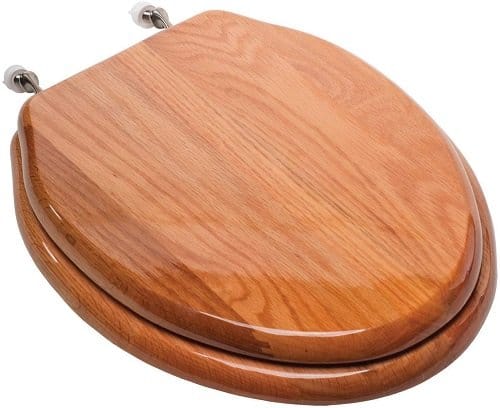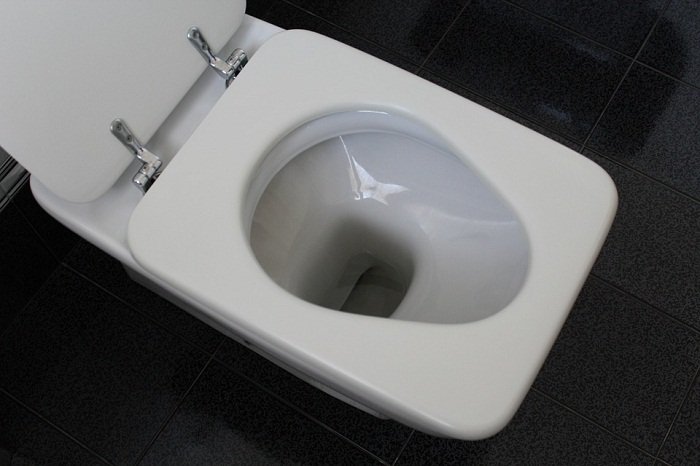Molded wood toilet seats have become a popular substitute for plastic seats. Although most residential toilet seats are made of plastic due to their lightweight and ease of cleaning, wood toilet seats are warm, comfy, and sturdy. They typically make great toilet seats for heavy people. In this guide, we highlight the various features of wood vs plastic toilet seats and why you would prefer one over the other.
Choosing Between Wood Vs Plastic Toilet Seats
While sitting on your toilet seat, take your time to figure out how comfortable it feels and whether or not it’s convenient to open and close, and clean. It will help you to make a perfect choice when you go for your next shopping. Below are some factors to consider while determining whether to go for a plastic or wood toilet seat.
1: Comfort
Most of us spend quite some time sitting on the toilet seat. The level of comfort the seat provides is one of the major factors you should consider while making your decision. Wood seats are strong and solid, depending on the finishing and workmanship. It may not feel cold in the winter seasons, unlike plastic seats that can feel cold and fragile.
In terms of providing comfort, it only depends on your preference. Therefore, it is hard to say one is better than the other.
2: Durability
Wood toilet seats are long-lasting compared to plastic toilet seats. It is one advantage they have over plastic toilet seats. Wood toilet seats are also sturdier and heavier than plastic toilet seats, so they don’t break easily.
On the other hand, plastic toilet seats tend to break at their joints where connective pieces connect the seat to the toilet base. The parts are purely plastic or metal material and would eventually break. It does not matter whether the pieces are made of metal or plastic material; it depends on the seat’s quality as a whole unit.
However, the durability of a wood toilet seat depends on its finishing. Despite its exquisite artistry, the shielding coat would still wear out over time, reducing its durability. Durability can also be compromised during toilet cleaning as scratches may occur and remove the protective finish. Besides, deformation may occur through overexposure to moisture in the bathroom.

3: Moisture and Cleaning
Moisture is the amount of humidity in the air. It is one of the vital factors to consider as it has to deal with your health. During hot summer months, backsides can get very clammy, and upon sitting on the seat, the moisture transfers to the seat.
Besides, careless men or kids who don’t aim well during nature calls would easily spill urine on the toilet seat. Toilet seats need better treatment to prevent them from absorbing moisture. Failure to appropriately treat wood seats would lead to permanent damping of the seat. Nose aching smell and molds may also thrive due to poor treatment. Lucky enough, plastic seats don’t often exhibit such problems as moisture trapped on the seat easily wipes off.
A wood toilet seat would be harder to clean than a plastic seat because the natural wood grain would form a slight texture where different elements would get trapped. The bottom line is that plastic toilet seats absorb less moisture and are easier to clean than wood toilets.
4: Cleanliness
Are wooded toilet seats hygienic? If you are considering an alternative for plastic seats, this question must have crossed your mind. The question is quite reasonable. During manufacturing of wood toilet seats, their finishing must be done well, and a quality sealant applied. This makes the seat hygienic enough.
However, additional protective measures are needed for wooded seats as the protective coat usually wears away with time. Wood is porous, unlike plastic, and cleaning is typically tricky. Cleaning plastic seats, on the other hand, only requires a simple sanitary wipe.
5: Warmth
Have you ever sat on your toilet and almost froze your butt? It becomes uncomfortable during cold seasons, as this occurs to many of us. Consider a seat that would be warm enough even during such cold weather seasons.
Plastic toilet seats can be a discomfort to sit on as they can get freezing. On the other hand, if treated well, wood toilet seats could provide much comfort, for they would remain warm even during the cold seasons. However, if not heated, they could still be as cold as plastic seats can be.
6: Cost
Factors such as brand, style, and materials used in making the seat would invariably affect the price. Their prices can range from $30 to a few hundred dollars. Toilet seats made of wood tend to be expensive, but their cost varies depending on the type of wood used in manufacturing. Conceivably, a wood toilet seat made from exotic wood would be more expensive. Plastic toilet seats are a bit affordable and can go to as low as $20.
7: Soft Closing
Whether it’s wood or plastic, a feature that most buyers check before buying any toilet seat is if it is a soft-closed toilet seat. Common toilet seats close very fast, producing a bang sound. As the toilet seat closes, it may develop scratches. This can lead to fading of the protective coat applied on it during finishing. Therefore, soft closing seats are highly preferable.
Plastic toilet seats with this special feature are now available in the market. Wooded seats with heavy lids would close forcefully, producing a loud sound. Plastic toilet seats are probably the best in terms of this feature.

8: Appearance
An attractive product would always shine and uplift your bathroom decor. Likewise, the appearance of the wooded and plastic seats would be a matter to you. Taking a keen observation of the product might make you impressed with one toilet seat over the other. If you are at home, check around and see what may powerfully blend with your existing decor.
Generally, wood tends to fit more of a traditional look, while plastic tends to fit better with a more modern look. If you love white or biscuit color, there are wood toilet seats such as Centoco 900-416 Wood Toilet Seat that are painted in various colors. Try them if you prefer wooded seats over plastic seats.
Pros And Cons Of Plastic Toilet Seats
Plastic toilet seats are made of plastic and come with either metallic or plastic mountings. These toilet seat models offer several benefits over their wood counterparts, such as lightweight, sanitary, etc. Here are the pros and cons of plastic toilet seats:
THE PROS:
- Durable
- Lightweight
- Scratch-resistant
- More hygienic
- Very versatile
- Usable in both public toilets and private toilets
THE CONS:
- They are cold
- Lower weight tolerance
- Less stylish
- Easily Stained by urine
Pros And Cons Of Wood Toilet Seats
Wood toilet seats can be manufactured from solid wood or molded wood. Solid wood toilet seats are much thicker and heavier as compared to molded wood toilet seats. You can quickly notice a solid wood toilet seat as it retains the original color of the wood it’s made from. On the other hand, molded wood toilet seats are painted in white or different varying colors, just like plastic toilet seats. Here are the pros and cons of wood toilet seats:
THE PROS:
- Looks stylish
- More Comfortable
- They are warmer
- Have a higher weight tolerance
THE CONS:
- Relatively heavy
- Less durable
- Less hygienic
- It can’t be installed in public restrooms.
FAQs
1: Which is better, wood or plastic toilet seats?
Wood toilet seats outshine their wood counterparts in terms of warmth and sturdiness. They tend to be thicker and heavier, making them less likely to break even when sat on by heavy people. However, plastic toilet seats carry the day when it comes to hygiene and stain and scratch resistance.
2: Do wood toilet seats smell?
Wood toilet seats can only smell when they are cracked or peeled off. When water and urine seep inside the wood, an awful odor will start coming out. A brand new and properly finished wood toilet seat does not usually smell.
3: How long do wood toilet seats last?
On average, a toilet seat lasts around 5-7 years. This is a critical consideration if you plan to sell your home but don’t want the toilet seat to become a point of contention.
4: What is the most hygienic toilet seat?
Overall, the Best Hygienic Toilet Seat is the BioBidet Supreme BB-1000. These innovative seats eliminate the need for toilet paper. They instead use a water nozzle to clean your private hard-to-reach crevices. The elongated bidet seat offers a three-in-one cleaning nozzle to ensure a spotless butt with every toilet visit.
5: Are wood toilet seats sanitary?
Porous materials often absorb more liquid matter than non-porous materials, meaning that a wood toilet seat is generally less sanitary than a plastic toilet seat. However, a well-maintained wood toilet seat can be just as sanitary as a plastic model. Just be sure to keep the toilet seat clean and free of moisture.
Bottom Line
If you are searching for a toilet seat and have got stuck in making a good decision, considering the factors mentioned above would be an excellent step for you. Distinct factors such as the soft closing feature, durability, and moisture absorption would give you a lead. However, if you are a stylish person, go for a wooded toilet seat due to its warmth and aesthetics. Besides, it can be highly comfortable than you expect.
